Dubrovnik, “the pearl of the Adriatic,” is one of the world’s most beautifully preserved medieval cities. George Bernard Shaw described it as “paradise on earth.” At the southernmost tip of Croatia, Dubrovnik is very picturesque, making it the most visited place on the Adriatic coast.
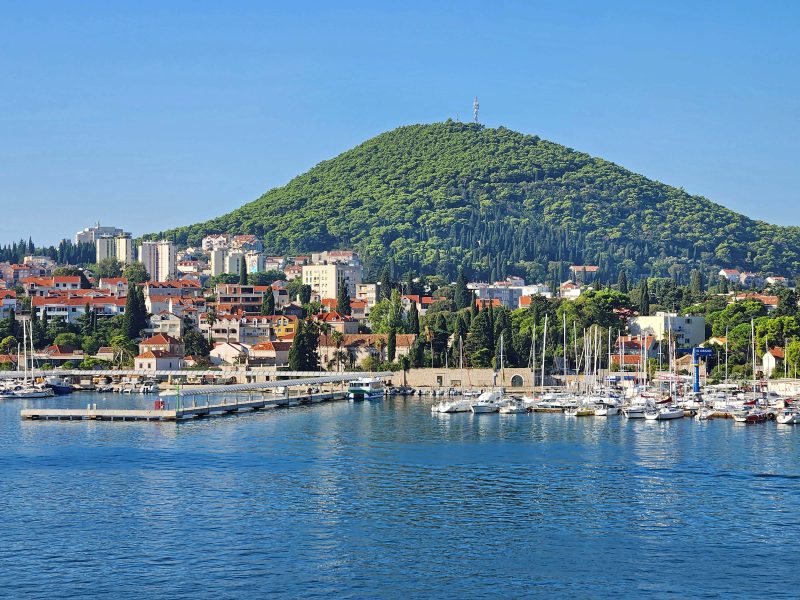
Fort Lovrijenac (don’t you love those Slavic spellings?), or St. Lawrence Fortress, also called “Dubrovnik’s Gibraltar,” overlooks the two entrances to Dubrovnik: the land and the sea. The Venetians wanted to build a fort on this spot in the 11th century to keep Dubrovnik under their power, but the people of the city beat them to it, building the fort themselves in just three months. When the Venetian ships arrived with building materials, they were told to leave, and the Venetians lost their power in Dubrovnik. It looks like kayaking is a popular activity in the fortress area.

A wall surrounds the Old City of Dubrovnik. It was built as a fortification to defend the city against the Ottoman Turks. For about €35 each, it’s possible for visitors to walk all the way around the Old City on the top of the wall. The distance around the wall is about 1.3 miles and can be completed in just over an hour if you hustle. Most people take 2-4 hours, with stops to take pictures of the Old City or to stop for refreshments at one of the three cafés along the way. There are 1,080 steps to go up and down as you walk on the wall, sometimes with 25-50 steps in a segment.
The entrance to the wall is at the Pile Gate, shown in the picture below. After purchasing a ticket, there are 75 steps to climb to reach the walkway at the top of the wall.

There were people walking everywhere along the wall.
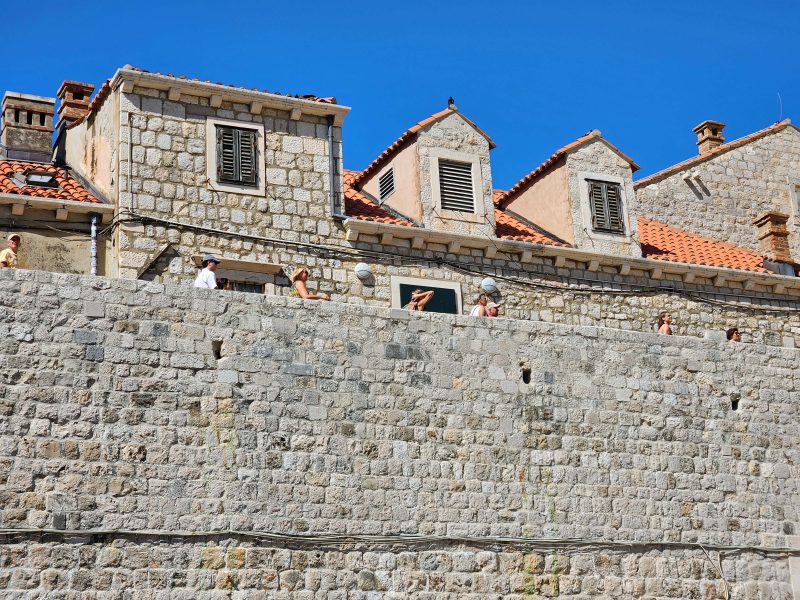
As we walked around the Old City, we came to this corner at the city wall. It was one of the settings for the “Game of Thrones,” so fans of that show might recognize it.

Dubrovnik receives little summer rain, so residents collected rainwater from their rooftops and stored it in cisterns. In 1438, Onofrio della Cava, a Venetian architect, was hired to build an aqueduct system to bring water to the city from a mountain stream about 7.5 miles away. Onofrio’s contract stated that his compensation would be penalized for every drop of water lost along the aqueducts. The final result was flawless. The city was so impressed, they hired him to design a sewer system as well.
The aqueduct system still works and was updated in the late 19th century to supply water directly to homes. Thanks to Onofrio, Dubrovnik has had a clean and constant water supply for nearly 600 years. The pipes are cleaned every few years, and photos have been taken to show how strong the structures still are. Given the ancient Romans’ brilliance in designing early water systems, this is probably not surprising.
The Onofrio Brunnen Fountain is the ending point of Dubrovnik’s 1438 aqueduct system. Onofrio designed this fountain with 16 sides. The “maskeron” design has a unique stone-carved masked face with a faucet projecting out of its mouth on each of the 16 sides. Originally, there were also statues around the dome, but they fell in an earthquake. The fountain still provides clean water for drinking and for filling water bottles, like the lady in the picture is doing.
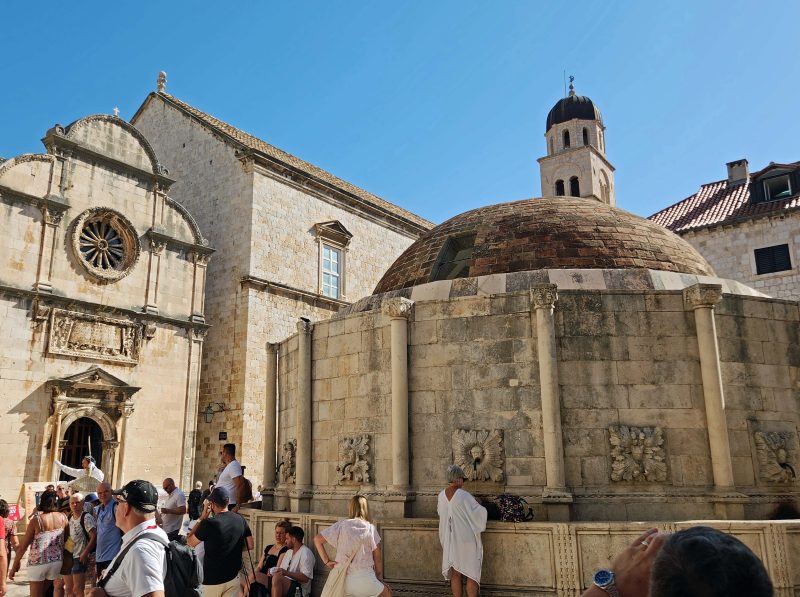
All of the Old City is a UNESCO World Heritage Site, so nothing can be changed, making it difficult to update things. To sell a protected building, it must first be offered to the government. If the government doesn’t want it, it’s expensive to buy and often hard to sell because of the UNESCO rules.
Today, about 1,500 people live in the Old City. Most places away from the main street require using some of the city’s 5.423 steps. As a result, older people tend to move into the new city and rent their Old City houses as Airbnbs.
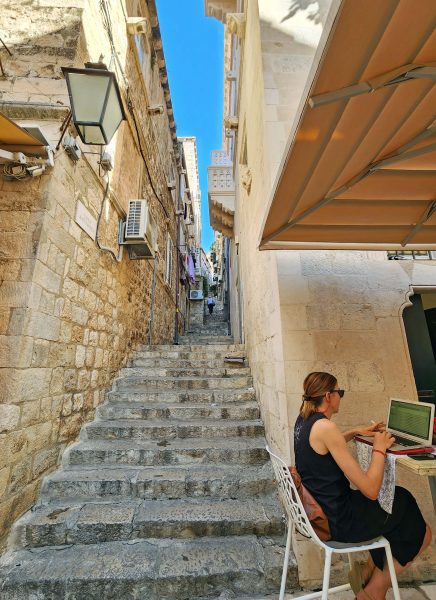
There are no elevators in the Old City buildings, so if you buy a large/heavy item like furniture, it needs to be carried up steps, like the washing machine shown in the photo below. The more steps it needs to be carried, the more it costs to get it there. Our guide said the owners of this washer are probably waiting for the “strong guys” to show up to complete their washer delivery.
Everyone has a washer, but few people have a dryer because the weather is so good for so much of the year that it’s much nicer to dry clothes outside on the balconies. In fact, we saw so many balconies with colorful laundry swaying in the breeze that the laundry looked like part of the city’s décor.

The streets of Dubrovnik are reasonably level across the mountainside but require some of those 5,000+ city stairs to go uphill or downhill to reach a parallel level street. Where the streets are level, sidewalk cafés and shops abound.
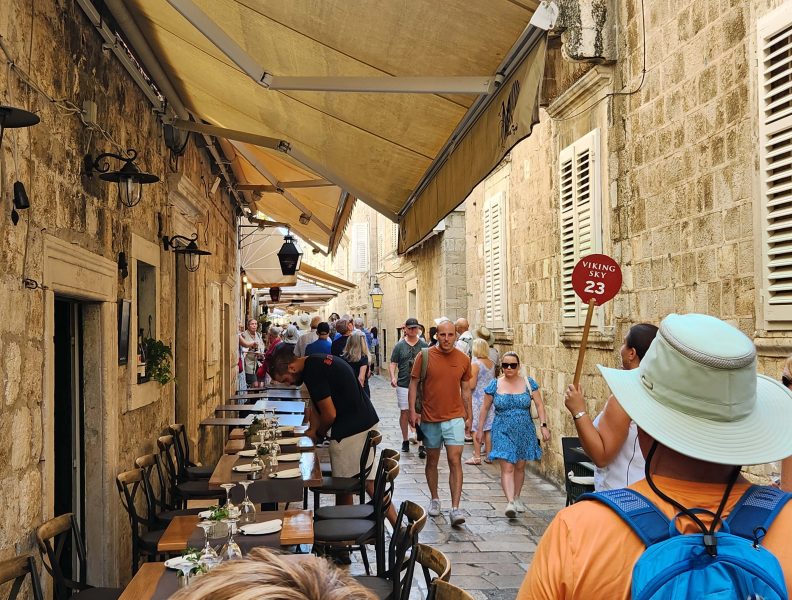
Early Dubrovnik had its own bishop, so there is a cathedral in the Old City, as well as a monastery that was established circa 1225. We were able to walk around the grounds of the monastery and to visit the museum on the premises. The photo below shows the Capital Hall leading to the vestry. The columns on the left support the belfry.

The courtyard of the monastery was very peaceful and soothing, with an old well in its center. The columns in the background, like those in the photo above, surround the courtyard.
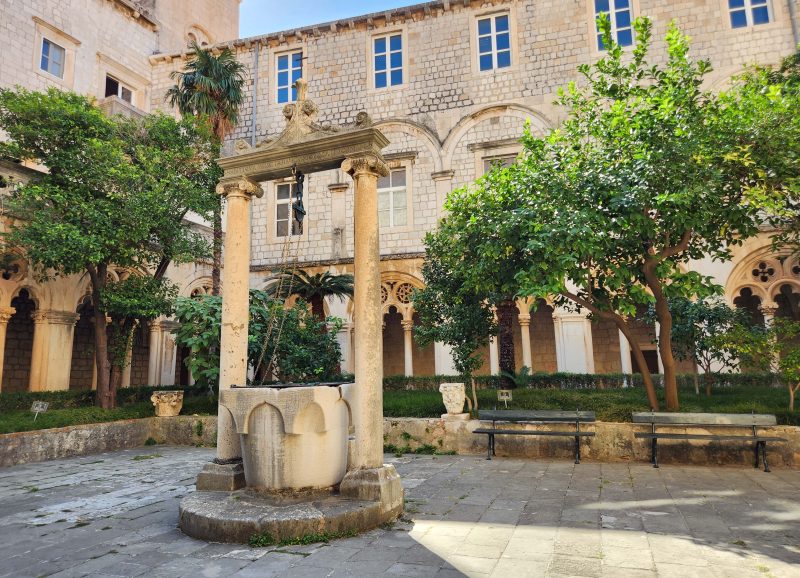
At the time of the Black Plague (1347-1351) people didn’t know about germs (discovered in 1676), but they figured out that people caught the plague from each other. As a preventive measure, Venice required ships arriving from infected ports to sit at anchor for 40 days before landing. Quaranta giorni is Italian for a 40-day period and evolved into the word quarantine.
The Venetian quarantine rules discriminated against ships and travelers from certain countries. Dubrovnik broke the Venetian rule in 1377 and required only 30 days of isolation in a nearby town or island before entering the walled city. The Dubrovnik guidelines were more just and fair, as well as successful, and soon prevailed around the world. The arrow in the photo below indicates Dubrovnik’s quarantine building—outside the Old City walls—where new arrivals stayed during the Black Plague.
